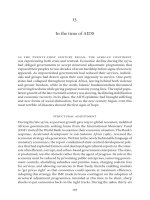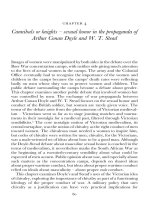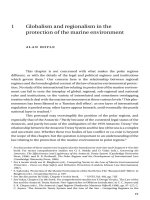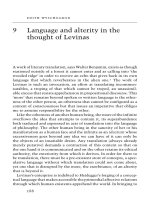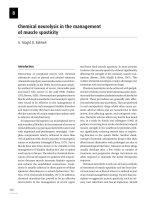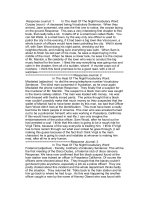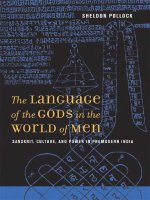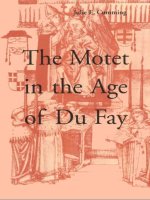Activating simultaneity in performance exploring robert lepages working principles in the making of gaijin
Bạn đang xem bản rút gọn của tài liệu. Xem và tải ngay bản đầy đủ của tài liệu tại đây (638.71 KB, 113 trang )
ACTIVATING SIMULTANEITY IN
PERFORMANCE: EXPLORING
ROBERT LEPAGE’S WORKING
PRINCIPLES IN THE MAKING OF
GAIJIN
Benjamin Knapton
Submitted in partial fulfilment of the requirements
for the degree of Master of Arts (Research)
Queensland University of Technology
Creative Industries Faculty
Performance Studies
2008
Acknowledgments
This thesis is dedicated to the memory of Kathleen Tierney – a daughter, a mother, a wife, a
grandmother and a musician. You are dearly missed.
I would particularly like to thank my supervisors over the last two years including: Judith
McLean, whose open, truthful and brave approach to life is an ongoing inspiration, Sandra
Gattenhof, for her constant commitment to my research and her rigorous approach to
academia, and David Fenton for his insightful and meticulous attention to all things
performance.
I am extremely grateful to Brad Haseman for his continued support and interest in my work,
which has always been so rich and fruitful, and Zane Trow for his perpetually insightful
dialogue.
My deepest thank-you to Robert Lepage and the Ex Machina team. The privilege they offered
me was deepened by the genuine openness I encountered at Ex Machina. Everyone in the
team was so welcoming. It is clear why such important work is created by this company. I
truly appreciate all that they gave me.
I would like to thank David Eastgate for his collaboration on the performance GAIJIN – his
intelligence and eclectic skill is incredible.
An infinite thank-you to my family for their continued support and love. My wonderful
privileged life and this research would not have been possible without them.
Lastly, I would like to thank my best friend Natasha Budd for her ongoing support, brilliant
mind, compassion and empathy that one can only hope will continue to spread.
2
TABLE OF CONTENTS
ABSTRACT ............................................................................................................................. 5
KEYWORDS ........................................................................................................................... 7
STATEMENT OF ORIGINAL AUTHORSHIP .................................................................. 8
PROLOGUE: FOREGROUNDING PROCESS .................................................................. 9
1.
INTRODUCTION ........................................................................................................ 11
1.1
2.
3.
METHODOLOGY ....................................................................................................... 17
2.1
Discovering the bricoleur....................................................................................... 19
2.2
Identifying as a constructivist ................................................................................ 21
2.3
Practice-led strategy............................................................................................... 24
2.4
Embodying methodology....................................................................................... 26
CONTEXTUAL CONCEPTS ..................................................................................... 28
3.1
What is devised theatre? .................................................................................... 30
3.1.2
Process ............................................................................................................... 31
3.1.3
Collaboration ..................................................................................................... 32
Concluding to begin again ..................................................................................... 34
UNDERSTANDING LIPSYNCH ............................................................................... 35
4.1
4.1.1
4.2
5.
Devised theatre....................................................................................................... 30
3.1.1
3.2
4.
Overview................................................................................................................ 13
The process ............................................................................................................ 38
The public rehearsal........................................................................................... 48
Conclusion ............................................................................................................. 51
CONCEPTUAL FRAMEWORK................................................................................ 53
5.1
Performance text .................................................................................................... 55
3
6.
7.
5.2
Simultaneity ........................................................................................................... 57
5.3
Synaesthesia ........................................................................................................... 62
5.4
Conclusion ............................................................................................................. 63
GAIJIN .......................................................................................................................... 65
6.1
An overview of the work and the process of collaboration.................................... 66
6.2
Process ................................................................................................................... 68
6.3
Conclusion ............................................................................................................. 81
FINDINGS AND NEW DIRECTIONS ...................................................................... 82
7.1
Activating simultaneity and synaesthesia .............................................................. 84
7.2
A theoretical offering ............................................................................................. 86
8.
REFERENCES ............................................................................................................. 89
9.
APPENDICES............................................................................................................... 93
9.1
Interview with Robert Lepage. 22/01/06 ............................................................... 94
9.2
Support letter from Robert Lepage ...................................................................... 110
9.3
Ethical Clearance Document................................................................................ 111
9.4
DVD of creative work GAIJIN ............................................................................ 113
4
ABSTRACT
In this research I have explored the performance making process of world renowned director
Robert Lepage. This exploration informed my own process, creating an original performance
called GAIJIN, where my roles included producer / director / designer and co-writer. The
practice-led research strategy employed in this research has allowed me to navigate the
sometimes slippery slope of connecting various performance discourses with the pragmatics
of the performance making process. The reason for this research is my strong interest in the
director’s role and my affinity with the practice of Robert Lepage.
My observation of the performance making process of Robert Lepage prompted the creation
of a conceptual framework informed by Hans-Thies Lehmann’s work Postdramatic Theatre.
These theoretical concerns were then further investigated in the creation of my own show.
This research process has uncovered a performance making process that foregrounds the
working principles of simultaneity and synaesthesia, which together offer a changed
conception of the performance text in live performance.
Simultaneity is a space of chaotic interaction where many resources are used to build a
perpetually evolving performance text. Synaesthesia is the type of navigation required – an
engagement consisting of interrelated sense-impressions that uniquely connect the
performance makers with the abundance of content and stimulus; they search for poetic
connections and harmonious movement between the resources. This engagement relies on
intuitive playmaking where the artists must exhibit restraint and reserve to privilege the
interaction of resources and observe the emerging performance. This process has the potential
to create a performance that is built by referential layers of theatrical signifiers and
impressions.
5
This research offers an insight into the practices of Robert Lepage as well as a lens through
which to view other unique devising processes. It also offers a performance making language
that is worthy of consideration by all performance makers, from directors to performers. The
significance of this process is its inherent qualities of innovation produced by all manner of
art forms and resources interacting in a unique performance making space.
6
KEYWORDS
The following is a list of keywords that appear within this exegesis or are associated with the
exegesis topic. These keywords have been listed for cataloguing purposes.
Collaboration, contemporary performance, devised theatre, interaction, intuition, performance
making, performance text, postdramatic theatre, process, Robert Lepage, simultaneity,
synaesthesia.
7
STATEMENT OF ORIGINAL AUTHORSHIP
The work contained in this thesis has not been previously submitted to meet requirements for
an award at this or any other higher education institution. To the best of my knowledge and
belief, the thesis contains no material previously published or written by another person,
except where due reference is made.
Signed: …………………………….
Date: …………………………….
8
PROLOGUE: FOREGROUNDING PROCESS
The need for this prologue comes from the nature of the content being presented in this
research. The performance making practice examined here emerges as a perpetually
transformative discovery process that has repercussions for the manner in which it is
discussed and the methodological approach I took. In an environment of perpetual
transformation my research foregrounds an open responsiveness which is apparent in the
layout of this exegesis; continual revision and modification allows this research to mirror its
content by being a perpetually transformative discovery process. Here, I will briefly discuss
the conflation of process and product in the performance making practice being explored in
this research.
My understanding of the performance making process I was exploring became clearer when I
discovered that a key attribute of Robert Lepage’s process, acknowledged by many theorists
in different forms, is the notion of provisionality. This term refers to “the assumption that all
arrangements appear to have been adopted on the understanding that they may well be
changed later. It refers to the incomplete quality [of the work]…” (Haseman 1999, 3). Lepage
recognises this when he says:
There’s something terrible in our system which is called opening night: it’s a
guillotine. We try to pretend that doesn’t exist, we just try and fade into the
performance area…we try not to decide ‘OK, opening night, so now this is officially
a show’. It is never finished (Lepage 2006, l. 110-115).
Acknowledging that Lepage frequently presents his performance works in public arenas, this
approach to performance making suggests a conflation of process and product where
performances with audiences present are used as a tool inside the devising process.
Aleksandar Dundjerovic (1999) recognises this in his thesis on the theatricality of Robert
Lepage when he comments on what he calls Lepage’s transformative mise-en-scene. He
9
suggests the “evolution of the ‘mise-en-scene’ is accepted as process rather than product…
the performance is in a constant process of rehearsals” (1999, 4).
The reason for this shift is Lepage’s unique process of devising; three or four week creative
developments reoccurring over a number of years with public rehearsals at the end of each
period. Dundjerovic suggests “the mise-en-scene evolves with the audience response as part
of its process through ‘open rehearsals’, making marginal the existing opposition between
rehearsal and performance. Thus performance becomes rehearsal…” (1999, 4).
This conflation of process and product is of crucial importance to this research. The
conceptual framework outlined in Chapter Five is examining a process of making
performance. Far from dismissing the performance moment with an audience present, this
research positions it as one part of an ongoing process.
10
1.
INTRODUCTION
11
1.
INTRODUCTION
My interest has always been in the making of performance and the director’s role in this
process. After reading the key text on Robert Lepage’s process Connecting Flights (Charest
1997), I became acutely aware that Robert Lepage was an artist whose practice resonated with
my own and therefore was someone I needed to engage with. As a researcher, Lepage, for me,
was what Margot Ely describes as a “gate keeper, that essential person who could provide the
permission to study” (1991, 20). As part of my research I interviewed Robert Lepage (9.1
Appendix 1) during the season of his one-person show The Anderson Project at the Sydney
International Arts Festival in January 2006. In interviewing him, my intention was to discuss
his process and, more importantly, identify the techniques or methods he utilises. This
intention was quickly re-aligned as our conversation focused on creativity and the
preconditions of a rich working environment, rather than exercises or methods.
I discovered that Lepage’s creative process is dramatically different every time. It is a
dynamic and adaptable process that creates itself as a direct result of its interactions with the
content being dealt with. Alexander Dundjerovic supports this by saying “it is a fact that
Lepage’s theatricality is founded on intuition, impulse and spontaneous discovery” (2003,
68). Within this dynamic, collaborative process Lepage aims to find a unique performance
(Lepage 2006, l. 197-208) – one that audiences will recognise and actively engage with. The
idea of the ‘unique’ resonates with writings on performance by Richard Schechner (2002, 24)
who suggests that a performance is not ‘in’ anything, rather ‘between’ in the unique
interactions. Lepage’s search for the unique reveals Schechner’s ideas in praxis – a
contemporary approach to performance making that views the world and everything in it ‘as’
performance.
12
Not surprising is that Lepage has an affinity with Bertolt Brecht. During our discussion his
concepts of art continually referenced this key theatre practitioner from the TwentiethCentury. “Brecht said … everything has to happen at the same time. When the writer is
writing his play, he’s also staging it, he’s also designing it, he’s also rehearsing it” (Lepage
2006, l. 130-132). This idea, coupled with Lepage’s suggestion that he works in a very
“unconscious and intuitive way” (Lepage 2006, l. 103), became the main interest of this
study.
Joseph Donohue and Jane Koustas suggest Robert Lepage “has become, along with Peter
Brook and Robert Wilson, one of the most admired stage directors in the world” (2000, ix).
Michael Hood identifies, “there has been a great deal of writing centering on reactions to
Lepage’s work [but] there has been little that focuses on his process” (2000, 128). This
research contributes to this void. The interview I conducted in January allowed a relationship
to form and an invitation to gain rare access to the artist and his company’s work. “Mr
Knapton is one of the few people selected personally by Robert Lepage to join his team as an
observer” (9.2 Appendix 2).
After this invitation from Lepage I decided my research would focus on the key working
principles of his performance making process and that I would attempt to implement my
findings in a creative process of my own.
1.1
Overview
This exegesis explores a performance making process that aims to create a provisional
performance text. It proposes a conceptual framework for understanding and actively
engaging in a performance making process that foregrounds intuitive playmaking and
13
audience feedback, where similarities, correlations and correspondences are used to build a
perpetually evolving performance text.
The framework presented here has emerged from my engagement with contemporary
performance discourse, the creative practice of Robert Lepage, and my own creative process.
It will include an exploration of specific concepts and stylistic traits attributable to the
emerging paradigm of postdramatic theatre and expand on them in two ways: the integration
of insights from my case study – observing the work of director Robert Lepage (as well as
extensive dialogue with him), and through the epistemology of my own theatrical process, of
which the creative presentation was a momentary example.
The entire research project was broken into two sections. These sections were framed by two
research questions respectively:
1. What are the observed working principles of Robert Lepage’s performance
making process?
This investigation consisted of a literature review, an interview with Robert Lepage
and a three-week observation of his performance making process in Quebec City,
Canada during October, 2006.
2. What is the impact of activating the observed working principles of Robert
Lepage in my own creative process?
This section consists of the creation of a one-person theatre show which I co-wrote,
directed and designed.
Accordingly, the outputs of this research have been organised in the following way:
Written Component (50%)
14
Exegesis:
Activating Simultaneity in Performance: Exploring Robert
Lepage’s Working Principles in the Making of GAIJIN
Creative Practice (50%)
Creative work:
GAIJIN
2.00pm and 6.30pm Tuesday 19th June, 2007
The steps I took from early 2006 to the present time are mirrored in the structure of this
exegesis.
Chapter Two explores the methodology I employed, which is qualitative in nature. The
interpretative paradigm is constructivist and the methodology employed incorporates the
research strategy of participant observation and practice-led research. Methods of data
collection included: interview, journaling, personal reflection, visual documentation, expert
and peer review methods and ongoing informal conversation. It was through the continual
revision of this methodology and the acceptance of an open space of engagement that
methods emerged through a direct response to the research site, paving the way for a project
in which methodology could become an “incarnation of [its] subject and themes” (Lepage in
Charest 1997, 164).
Chapter Three presents contextual concepts that I investigated before my observation with
Robert Lepage and Ex Machina. It theorises a devised approach to performance making and
the nature of collaboration essential to this process. It uncovers my key concerns at this time
and provides an entry point to the unique qualities of a devised performance process.
Chapter Four discusses the case study of Robert Lepage’s creative process for LIPSYNCH. It
describes the process I witnessed, supported by an interview I conducted with Lepage,
15
extracts from my journal, visual documentation and literature pertaining to his work. The
placement of this initial data presentation is essential because it uncovers the genesis for the
conceptual framework explored in Chapter Five and further investigated through my own
creative practice in Chapter Six.
The conceptual framework detailed in Chapter Five outlines three key concepts: performance
text, simultaneity and synaesthesia. The history of these concepts is explored, as well as their
recent significance in contemporary performance discourse. This section continues to
reference the process of Robert Lepage to keep these sometimes abstract concepts grounded
in the pragmatics of performance making.
Chapter Six describes the implementation of the conceptual framework in my own creative
process, with the creative presentation GAIJIN being only one moment in a perpetual process.
This chapter describes the creative process undertaken, as well as identifying moments of
praxis during the performance making period and feedback received after the public rehearsal.
It will draw on theory already encountered in Chapters Three and Five, as well as creative
ideas expressed by Robert Lepage.
Chapter Seven presents my findings from this research project, including suggestions for
future research and the implications this way of working has for directors and artists. It also
contains a theoretical discussion that identifies the relevance of visual arts theory from the
1900s in this research. The theory examined serves in reconciling the tension between
performance discourses brief and somewhat lacking examination of simultaneity, and the
pragmatics of the process being discussed throughout this exegesis.
16
2.
METHODOLOGY
17
2.
METHODOLOGY
At the 2006 Sydney Festival I had the opportunity to interview world renowned contemporary
theatre director Robert Lepage. Following this meeting I was personally invited to join his
company, Ex Machina as an observer in Quebec City, Canada in October 2006. During this
period of privileged access I was able to observe and discuss Lepage’s innovative process and
begin to unravel the key working principles I observed. On my return to Australia I
immediately entered a creative process, in the role of producer / director / writer / designer,
where I was able to conflate my own process with the key working principles I had identified.
This chapter identifies a dynamic and transformative lens through which to view the creation
of a stage performance by Robert Lepage, the subsequent working principles identified from
this process and the integration of these in my performance making process. The importance
of dynamism and transformation is found in the relationship between my research approach
and the performance making process being explored. By foregrounding responsiveness
throughout this research, I have created layers of understanding presented in multiple forms
throughout this document, as well as the presentation of my creative work GAIJIN. These
layers represent the steps taken in my research journey, and in addition provide a multi-vocal
exploration of the key concerns of this research.
The chapter will specifically explore the significant characteristics of qualitative research as
well as the practice-led strategy employed; it will explore my identification as a constructivist
and describe the methods used to obtain data. This chapter also invokes the epistemological
and ontological qualities of Robert Lepage’s work, and the process being explored in this
research that calls for these tools to be used.
18
2.1
Discovering the bricoleur
In contemporary times an important attribute of qualitative research is the capacity for
multiple voices to be heard, challenging the assumption that there can be an objective view of
the world. The qualitative researcher aims “to implement a critical interpretative approach
that will help them (and others) make sense of the…conditions that define daily life in the
first decade of this new century” (Denzin and Lincoln 2005, xiv).
This development of the field has caused the researcher to become a ‘bricoleur’ (Denzin and
Lincoln 2005, 4), defined by Levi-Strauss as a “Jack of all trades or a kind of professional doit-yourself person” (cited in Denzin and Lincoln 2005, 4). Denzin and Lincoln outline five
types of bricoleurs. Utilising their definitions I position myself as an “interpretative bricoleur”
who produces a “bricolage – that is, a pieced-together set of representations that are fitted to
the specifics of a complex situation” (2005, 4). In this research, the pieced together
representations include my observations of Lepage’s process, my examination of
contemporary performance discourse and my own creative process. These representations are
made up of multiple voices and methods of data collection in order to contribute to a complex
situation: the theoretical field of contemporary performance and, more specifically, the
performance making process being explored in this research.
Another important aspect of the bricolage is the use of the researcher’s own knowledge of the
given context or phenomena to design the project. Joe Kincheloe in her article “Describing
the Bricolage” suggests “in making…assertion[s] the bricoleur is displaying philosophical /
epistemological / ontological sensitivity to the context of the analysis” (2001, 688). Far from
losing a grounded research path, this approach allows the researcher to connect the theoretical
field of their research with the particulars of their focus by selecting relevant tools from the
broad range of methods available – thereby continually finding connections between the
19
philosophical / epistemological / ontological nature of the methods used and the research site.
This concept of emerging methods has strong metaphoric links to the nature of form in the
work of Robert Lepage. This is demonstrated in his assertion that
In the theatre, the audience has to be immersed in the show’s argument, and to be
immersed in the argument every sense has to seize it and so the form has to become
an incarnation of the subject and themes (Charest 1997, 164).
Moving toward a written exegesis as well as a creative work, the fusion of research methods
and content as well as identifying as an ‘interpretative bricoleur’ (Denzin and Lincoln 2005,
4) becomes significant, because “the solution (bricolage) which is the result of the bricoleur’s
method is an [emergent] construction” (Weinstein & Weinstein cited in Denzin and Lincoln
2005, 4). This ‘construction’ is continually fluid “as the bricoleur adds different tools,
methods, and techniques of representation and interpretation to the puzzle” (Denzin and
Lincoln 2005, 4), allowing the product of the bricoleur’s research to be interpreted by the
reader – acknowledging “people as constructive agents…whose ways of knowing, seeing,
understanding, and valuing influence what is known, seen, understood, and valued” (Spivey
1997, 3). Pribram suggests: “To be human is to be incapable of stagnation; to be human is to
productively reset, reorganize, recode, and thus to give additional meaning to what is” (cited
in Spivey 1997, 1).
These approaches to research feel essential to me, given the strong connection to the
performance making process being explored here. An example of these strong connections
would be Robert Lepage’s approach to performance building where he holds public rehearsals
asking the audience to contribute to the performance writing process. The relevance of this
process for him is to “let people inform you of what it is that you’re doing” (Lepage 2006, l.
99-100).
20
2.2
Identifying as a constructivist
In this research project I adopted a constructivist approach. Constructivism is the active
construction of knowledge while interacting with a perceived world. In order to focus on and
explore the key working principles of Robert Lepage’s performance making process it was
necessary to locate myself reflexively and flexibly within the field of contemporary
performance making. By framing my research through the interpretative paradigm of
constructivism I adopted what Denzin and Lincoln describe as “a relativist ontology
(relativism), a transactional epistemology, and a hermeneutic, dialectical methodology”
(2005, 184), working toward a “reconstructed understanding” (2005, 184) of the key working
principles of Lepage’s creative process. Nancy Spivey suggests constructivism emphasises
“the generative, organizational, and selective nature of human perception, understanding, and
memory – the theoretical ‘building’ metaphor guiding thought and inquiries” (1997, 3).
Agreeing with this assertion, this study intends to add to the construction of discourses
engaged in exploring the process of Robert Lepage as a performance maker, with an emphasis
on building knowledge that is interpretable, dynamic and open. Spivey suggests it is this very
“instability that is productive, generative” (1997, 120) and fittingly lends itself to past
definitions of theatre or performance: theatre is a “self destructive art, it is written on the
wind” (Brook 1968, 18); theatre “is a movement towards meaning rather than a fixed set of
meanings” (McAuley 1996, 142). This instability is based in the interactions between the text,
whether it be performance or written, and the reader, hence Denzin and Lincoln’s choice of
adjectives: relativist; transactional; hermeneutic; dialectical (2005, 184).
The interactions inherent in the constructivist paradigm being managed in this study
incorporate that of the researcher and site, the reader and thesis, and the reader and creative
work. Wolfgang Iser discusses this interaction, suggesting the “text itself simply offers
21
‘schematised aspects’ through which the aesthetic object of the work can be produced” (cited
in Counsell and Wolf 1980, 179). Based on this understanding, he goes on to explain that a
text has two poles, the artistic and the aesthetic. “The artistic is the author’s text, and the
aesthetic is the realisation accomplished by the reader” (1980, 180). It is between these two
poles that the actualisation of the piece is possible, incorporating the ‘schematised aspects’ of
the text and the subjective response of the individual. In Iser’s analysis there is a construction
process ever present, as the reader or spectator accomplishes a realisation of the text they see.
Therefore, this “reconstructed understanding” (Denzin and Lincoln 2005, 184) or realisation
is relative to the persons or groups who are a part of it. Also relative is the extent and validity
of the knowledge obtained and presented.
So, without becoming a nihilist, how does the methodological lens of this study contend with
the unstable territory of interpretation? Spivey raises this concern in what she calls the
“constructivist predicament” (1997, 70). This is the contradiction between the constructivist
notions of everything as subjective, whilst at the same time developing a “constant, stabilized
representation of a particular text” (1997, 70) or “reconstructed understanding” (Denzin and
Lincoln 2005, 184). This concern is paramount to the concept of constructivism, to
performance in general, and consequently to this study. Its significance in performance is
exemplified by Umberto Eco’s concept of the open work. He suggests the open work
locates the infinite at the very core of the finite…It means that every phenomena
seems to be inhabited by a certain power – in other words the ability to manifest itself
by a series of real or likely manifestations (1989 [1962], 182).
Although one representation may have been chosen, be it an interview or action on stage,
inherent in this is the possibility for all other manifestations. Although this could be
considered quite an abstract concept, the metaphoric connections to the process being
examined here seem too good to let go.
22
In the field of qualitative research Spivey describes two approaches to dealing with this
concern: the “consensus approach” (1997, 70); whereby a small number of people with some
expert knowledge establish an “interrater reliability” (1997, 70); and the “authority
approach… [which] provides theoretical justification by citing authorities” (1997, 70-71).
Utilising both of these processes, it was possible to conduct a dense exploration through
multiple voices commenting on the same concepts and problems. Theoretical concepts, like
Eco’s and others, were also used to place the discussion in a structured framework. Working
in this web of information and interactions can provide multiple perspectives on ideas and
issues with intersecting points held together by the context of the study. It is in these moments
of inter where the power of the infinite can be found.
Fundamental to this study is Spivey’s concept that “transformation is integral to the
constructive process” (1997, 120). Discussing the meaning-making processes of individuals,
Spivey (1997, 39) cites Frederick Bartlett’s two processes: “the tendency to conserve what
fits and the tendency to appropriate the new and elaborate it so that it is more familiar”. These
processes became important to this study as sometimes abstract, theoretical concepts of
contemporary performance were used as a thematic lens through which to view the chosen
site, therefore preliminarily conserving what has been suggested to fit. Catherine Fosnot
(1992) calls this the “initial assimilatory structure”. As data is gathered from the research site,
the theoretical concepts will enter a dialogue with the observations made and lead to a
transformation of them within the given context. This allows for “simplifications, regroupings
and modifications” (Spivey 1997, 40) within the spaces that emerge. This is exemplified in
this research by my inclusion of the contextual concepts presented in Chapter Three. This
assimilatory structure allowed for a dialogue between established theoretical concerns of
performance discourse and the unique phenomena observed or practised in the performance
making process.
23
2.3
Practice-led strategy
The transformational and symbolic demands of this research lead to the principal
methodological strategy being practice-led, for which Carole Gray offers the following
definition:
By 'practice-led' I mean, firstly, research which is initiated in practice, where
questions, problems, challenges are identified and formed by the needs of practice
and practitioners; and secondly, that the research strategy is carried out through
practice, using predominantly methodologies and specific methods familiar to us as
practitioners (1996, 2).
Before undertaking this research I was certainly asking questions about my and others’
directorial processes. I was consistently uncomfortable with an exercise or method approach
to performance making and searched for a more organic meeting place where the process was
determined by the content. When I started to engage with the work of Robert Lepage my
interest in these questions intensified.
Within this research I located myself, as a bricoleur and constructivist, within the
performance making space of Robert Lepage in order to further explore my questions,
discomforts and hopes. This approach to research is observed by Carole Gray when she says:
“artists… are claiming ownership and taking responsibility for the critical reflection and
evaluation of their own peers’ practices” (1996, 8). This was true in this research, but I also
needed more than this; I needed to take my findings and explore them through my own
practice; my own processes. Again I found researchers who had observed this need by
practitioners, namely Egon Guba, who suggests that the “choice of methodology should be a
consequence of ontology and epistemology” (cited in Gray 1996, 12); a process that is
determined by its content.
24
In regard to Gray’s suggestion that practice-led research “is carried out through practice”
(1996, 2), I took the step of embarking on a performance making process of my own, which
offered the opportunity to gain more insights into the phenomena I had identified and was
continuing to explore. Brad Haseman suggests:
Practice-led researchers construct experimental starting points from which practice
follows. They tend to ‘dive in’, to commence practicing to see what emerges. They
acknowledge that what emerges is individualistic and idiosyncratic (2006, 3).
The need for a practice-led approach imbedded in my own process was dictated by my
previous findings in Quebec City. A key attribute I had identified in the initial research cycle
was the conflation of form, content, process and product. This conflation involves the
interaction of form, content and audience feedback which perpetually infuses the provisional
performance text. To understand this type of performance making process in more depth it
seemed a combination of my own content, processes and artistic ability would need to be
employed. Within this open, fluid and dynamic performance making process, a practice-led
approach offered a methodological working space that allowed a deeper understanding of the
key elements I had identified as they flowed into and became transformed through my own
practice. My main methodology had become “responsive, driven by the requirements of the
practice and the creative dynamic of the artwork” (Gray 1996, 15).
As a direct result of the conflation of form, content, process and product in the processual
phenomena being examined here, as well as the inherent transformation and development of
the performance text, a need arose for part of this investigations output to make “claims to
knowing” (Haseman 2006, 3) through symbolic language and the unique form of its
performativity. This second cycle of research certainly suggests “that practice is the principal
research activity” (Haseman 2006, 6). My performance making processes became the
methods of research, the steps I took in order to create the findings. The process I embarked
on was about creating a work where a traditional journey from text to performance is
25
